View Post [edit]
| Poster: | dead-head_Monte | Date: | Jan 27, 2011 12:56pm |
| Forum: | GratefulDead | Subject: | double-recording eliminates cuts due to reel-flips |
1994 - Qatar Cablevision operations - the Studio side of their Bus
11 a.m. in Doha -- it's 10 p.m. "last night" in Denver -- time to smoke a bowl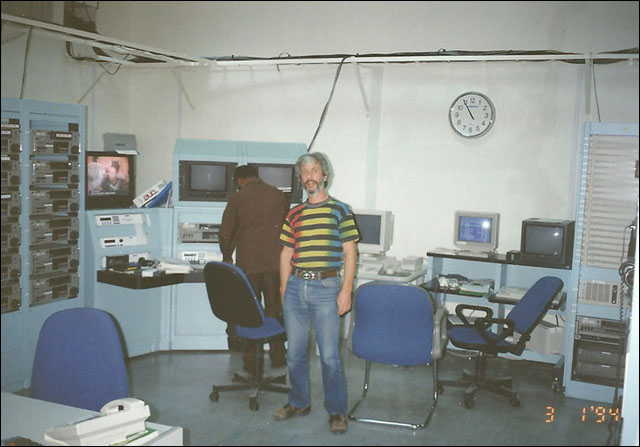
Somali-Ali was one of my best friends. Ali was pretty up-to-speed on the MTV-channel automation system. After smoking my bowl outside, I'm messing with Ali's head, "Ali, quick, check the problems with our Automation. What just happened?" Then I generate a manual "tape not cued" error, by fast-forwarding a tape.
Ali is not buying into my clown routine anymore!
The heartbeat of this state-of-the-art system was expensive proprietary software applications for creating, editing, and executing VCR record & playback Schedule instructions. This software was running on a custom-built 486 PC-clone operating a UNIX file server. The automation computer was outputting machine-code instructions to a network of proprietary remote control interfaces. All this equipment -- including dozens of M-format VCRs, and 4 off-line Edit Bays -- was just for one single channel in QCV's cable lineup. In Qatar, Hong Kong's MTV channel was heavily censored. This was a 24-hour, tape-delayed, stroke-of-genius. But, all their VIDEO editing tapes was very labor-intensive, even though all recordings and playbacks were 100% automated. They removed cleavage shots, grinding shots, booty shots, kissing shots, and violence shots. They also removed any cursing and swearing by muting the Audio during these times.
equipment racks housing MTV's tape-delayed Automation system
Where the heck are all these foreign TV signals coming from? Most people never knew that Qatar aired all this stuff in The Persian Gulf as early as 1994. Photos were taken in 1994 by David Morse, microwave engineer from Denver, Colorado.
QCV's satellite control system -- the antenna array ("dish farm") was out back
Last, but not least, was the most sophisticated TV equipment installed anywhere in the Persian Gulf in 1994. Built by an outfit in Belgium, and modified by Merlin Systems, were two "instant replay" TV special effects systems. Merlin fitted both boxes with a special GPI (general purpose interface) kit. These interfaces functioned as "mice" devices for both of these digital video systems. The mice are shown in the photo below. The mice are on the table in the foreground, being the square white boxes. Belgian design engineers spent scores of hours designing very effective controllers for Sports broadcasting. Instead, these boxes were used at QCV strictly as a fixed digital delay, with 20 seconds of video delay, in real-time. They were normally used by expensive TV Trucks, for doing all types of instant replays, when broadcasting sports events. Shown on the table, behind Merlin's custom mice boxes, are the very expensive instant replay control panels "never in use." Observe the dual stacks of 2 TV monitors each, in the photo below. The stack on the left is QCV's "live video" feed, into the digital delays. The stack on the right is their delayed video, being output 20 seconds later. The French "Canal Channel" is the video you see on the top monitors. Qatari censors had 20 seconds to decide whether to censor any long kisses, whiskey drinking, nudity, etc. Just hit the "freeze button" on Merlin's mouse box. The picture goes frozen, and is broadcast this way to all of Qatar, on QCV's MMDS Cable system. Hit the "unfreeze button" after the long kissing scene is over, and cable subscribers are once again returned to live video. Subscribers and viewers watching are responding, "WTF!!!"
QCV real-time digital censoring's control systems -- my good friend Adnan is on duty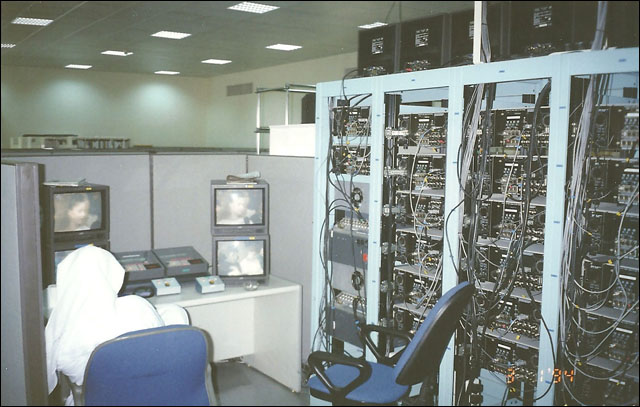
The instant replay digital boxes that Merlin modified can been seen in the equipment racks shown in the above photo. They are installed in the left-most rack in the lower section. They are the 2 gray-shaded boxes with the exhaust fans shown. Another thing Merlin did was to modify Tape Recorders - the same thing Ron Wickersham did to the Ampex 16-track tape deck for the Europe '72 reels that were recorded by Alembic Sound. That is, on some Ampex model video tape recorders (VTRs), Merlin Systems modified the tape transports, turntables, and reels to accommodate larger Reels. This was so the customer could get more time recorded on a VTR's tape reel before doing a required reel change at (or near) the end of tape. In particular, Merlin was modifying Ampex's early model one-inch VTRs such as the VPR-2B. Merlin's modifications (moving the reel hubs outward) enabled early Ampex one-inch VTRs to Record and Playback large 2-hour reels, instead of the factory 90-minute maximum reel sizes. At the end of the day, Reel Changes were required during taping of live recordings. When customers were taping long recording sessions, they had to plan in advance what strategy they would be using. Larger reel sizes for VTRs and ATRs did not solve all the issues and challenges associated with live recordings and reel flips. Ampex introduced the VPR-3 model one-inch VTR in 1983. The VPR-3 was able to accept 2-hour tape reels. In the photo below, an Ampex VPR-3 is threaded with 2-hour video tape reels.
Ampex VPR-3 with 2-hour reels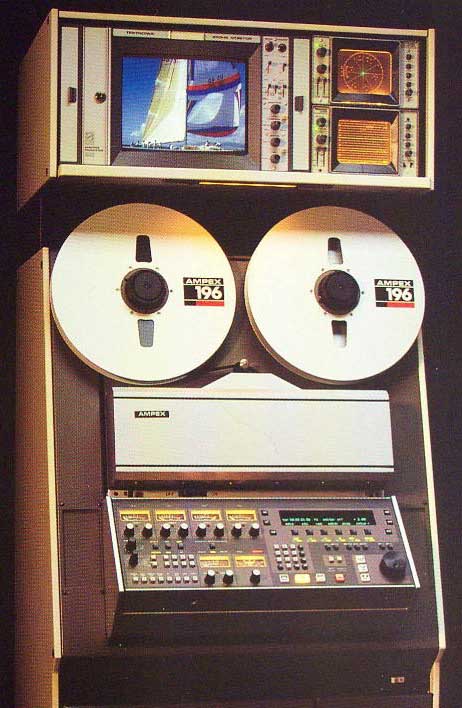
Recordings and Reel Changes discussion To further illustrate the strategy and expense considerations of Tape Recording live events, and managing Reel Flips, consider how The Networks handle this. Everything was taped and played back in redundancy. Redundant records and playbacks are (were) used all the time. If one source goes bad for any reason, the other source is always there as a "hot" standby. In Qatar at QCV, for the MTV-channel 15-minute recording-overlaps, we had 4 tape recorders rolling: 2 tape decks recording during their reels' final 15 minutes ("A" reels); and the 2 tape decks that just began recording new reels ("B" reels). Reading some documentation, interviewing the crew, and listening to tapes can help figure out what was what, regarding Grateful Dead tapes, reel-flips, patches, tape sources, their lineages, and their recordings in circulation.
This post was modified by dead-head_Monte on 2011-01-27 20:56:05
Reply [edit]
| Poster: | dead-head_Monte | Date: | Jan 27, 2011 12:51pm |
| Forum: | GratefulDead | Subject: | Re: double-recording eliminates cuts due to reel-flips |
QCV's MMDS - the Microwave side of their Bus
Receiving QCV's MMDS 2.5 GHZ microwave signal -- Doha, Qatar, "out in the field"how to acquire the QCV MMDS signal with your kit -- the Temps exceeded 110° F
-- tripod, mast, antenna, downconverter, decoder box, TV set, signal strength meter --

installing a "microwave beam bender"
Q-Tel's studio site in Doha is where the microwave transmitter tower was located. The transmission room had 28 microwave transmitters operating on adjacent channels at 2.5 Giga Hertz. These signals were mixed together in a special set of waveguides called a combiner. The combiner output signals into special cables, and these were wired up to the antenna arrays on the tower. The antenna array was designed and fixed for achieving maximum transmit signal footprint spread onto the main population centers. On the downside, MMDS microwave transmission can leave "holes" in the signal's footprint, or coverage pattern. These holes present an absence of signal. A local well-to-do Sheikh was one such victim. He kept complaining about it, and he kept at it, but he was a very cool man. A couple of months later, we installed QCV's first beam bender to resolve his signal problems - or, lack thereof. Lead microwave engineer Dave Morse designed it. This included some mechanical rigging designs, blueprints, and local fabrications in Doha. Monte reviewed it. Engineers in Denver approved it.
getting a ladder put together -- "improvising in the field" -- barrel rolling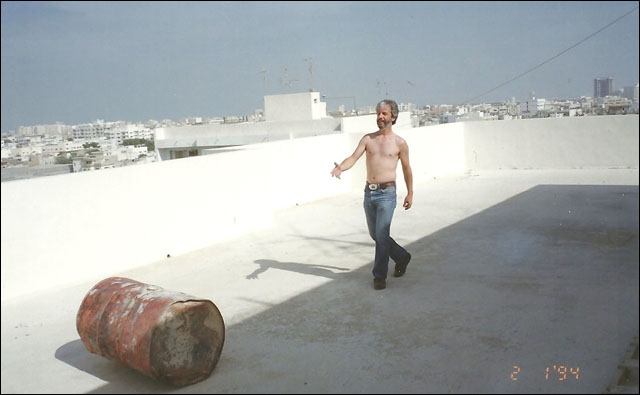
the barrel is always a good starting point -- too bad the bottoms were rounded, not flat
add some concrete blocks -- okay, stack 'em up -- the base is unsteady and shaky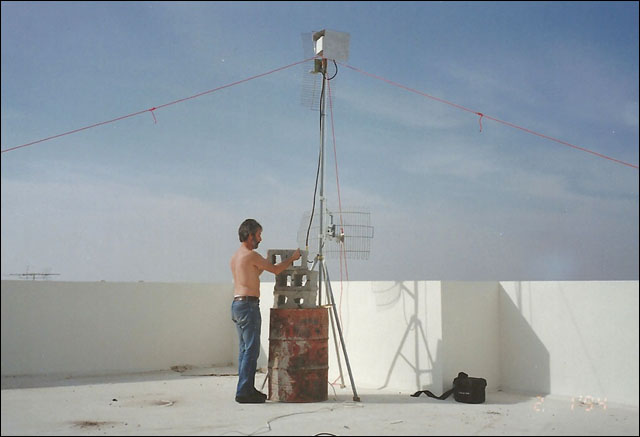
What the heck is a beam bender? MMDS microwave cable signals were operating at 2.5 GHz. Best way to receive this signal is using a sectional parabolic antenna. This signal is transmitted with vertical polarization. Therefore, the receive antenna, on top of this mast, is mounted in a vertical orientation. Maximum signal stregth gets obtained, when the signal is tuned in by aiming the receive antenna toward Q-Tel's transmission tower. The white box on top of this mast is a custom-built hybrid RF device. In short, it's a receiver / transmitter. The antenna at the bottom of the mast is transmitting the "new signal" in a horizontally polarized orientation. This helps isolate the one signal from the other. Here the "new signal" is transmitting in a different direction and is filling the hole that the well-to-do Sheikh had with the "old signal." Aim this new signal at The Sheikh's villa, and visa-versa, and you have it -- beam bending microwave signals. How about a friggin' ladder? For not much more than $50 thousand annual pay, and 60 hours a week, Monte makes an unusual decision. Screw everything: let's get this thing done, and get back into some air-conditioning. Risking life-and-limb, at the edge of this 12-story building's rooftop, I made my decision: go for it! Somebody has to hook this thing up, get it together, and finish doing all the fine tuning.
standing on my tip-toes -- "improvising in the field" -- and defying death
getting my finger on it -- usually requires an "attitude adjustment"
fine tuning the beam bender's transmit antenna -- "line-of-sight method"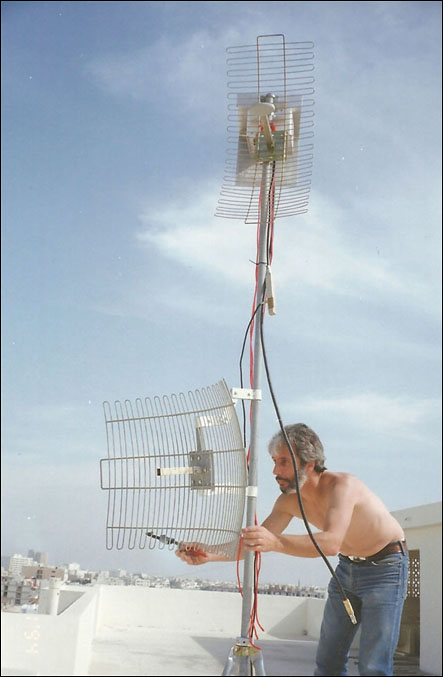
that's it, lock it down right there -- new signal is "melting the TV" at The Sheikh's villa
new attitude is "beginning to sink in" -- another day in Doha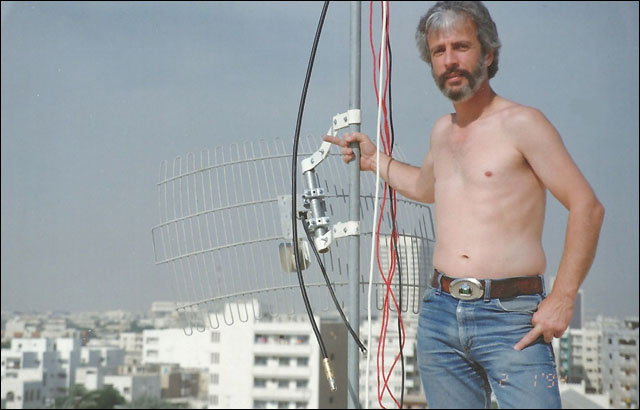
Finish the hook-up and start packing up. The Sheikh just called us. He's in his villa across the street. We just finished our mobile telephone conversation. He's so happy, he's gonna run down the street to his mosque, and go pray. Dave Morse captures Pakistani-Amjad, arriving at our site just as we're leaving. Amjad is QCV's insallations coordinator. QCV had contracts with numerous Dealers in Doha, and these outfits did all the subscriber installs there. Hey, as long as Amjad is keeping QCV customers happy, I'm good with that. Dave and I were making Amjad "look good" everyday at work.
Amjad showing up late as usual & taking most of the credit -- in this mug-shot -- Priceless!!!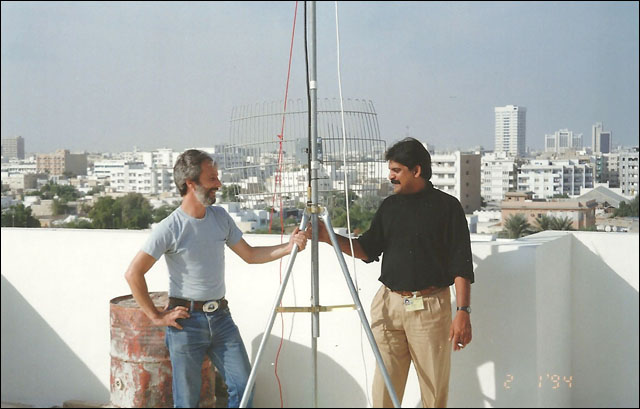
Denver's Dave Morse -- microwave engineer -- our photographer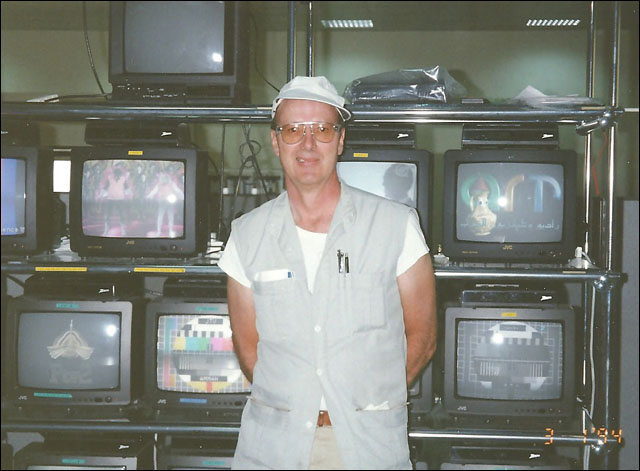
Monte left QCV and TVCN shortly after risking his life, making sure to document the most ridiculous stuff. This incident is just one small scrap in a plethora of insanity. I worked for several sponsors in Doha. It was one crazy year in my life. David Morse finished out his one-year contract with TVCN. Gulf Airlines had just introduced their new non-stop flights from Dubai to JFK in New York when Dave flew home. I remember the day he left. I was stunned when Dave blew an extra $1000 on that new non-stop flight, just to get home 8 hours faster than normal flights could. I'm telling you, I appreciate living in Colorado, U.S.A. much more than you know. Peace. Bring our Troops home now.
This post was modified by dead-head_Monte on 2011-01-27 20:51:12
Reply [edit]
| Poster: | Judge TOOTMO | Date: | Jan 27, 2011 10:14am |
| Forum: | GratefulDead | Subject: | Re: double-recording eliminates cuts due to reel-flips |
You sure about that Monte? Cause I'm looking at you in the first pic and you're kind of wavering which is really strange since this is photograph. I'm thinking you held it just a little too long and now your trying to enter another dimension. Of course, could just be that shirt you're wearing.
TOOTMO
Reply [edit]
| Poster: | dead-head_Monte | Date: | Jan 27, 2011 10:54am |
| Forum: | GratefulDead | Subject: | Re: double-recording eliminates cuts due to reel-flips |
here's one of my Business Cards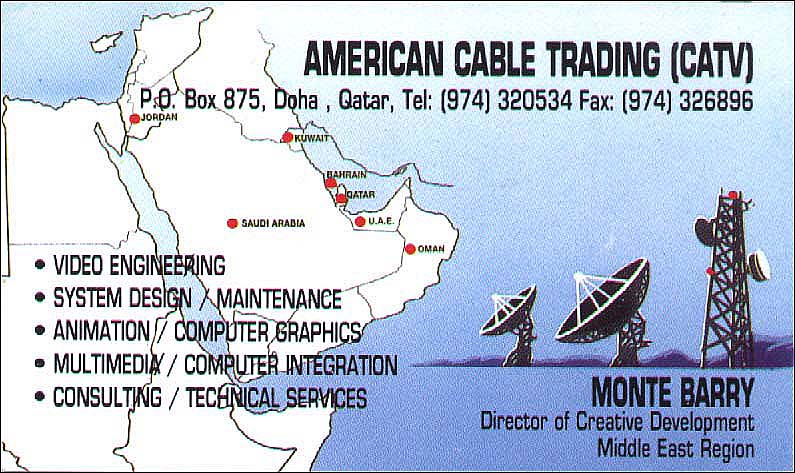
My employer was a Denver outfit named TVCN. We were deploying $multi-million systems and video technology for Q-Tel, the Qatari Telephone Company. We were the only outfit in the world that was able to meet Qatar Cable Vision's needs, which they tendered out in a worldwide contract bid offering: design and build a 28-channel MMDS wireless cable TV system for the State of Qatar; transmission signal must be scrambled and secure; provide QCV with real-time censoring systems for 2 cable-TV channels (France's Canal Channel was one); and, provide QCV with a computer-automation system for delivering Hong Kong's MTV Channel in a 24-hour, tape-delayed format, to be edited and censored. Very few people know what happened over there. The first customer (subscriber) installations were done for The Emir of Qatar, and for all 4 of his wives' residences! Next in line were all the bigtime Sheikhs, starting with the most powerful ones, and working down the list. I met them, and I visited the largest Mosques in Doha. Qatar's C.I.D. investigators ran a thorough and lengthy background check on me, using a fine-toothed comb. After that, I was issued the rare and coveted Multi-Entry Visa. They trusted me. I traveled around the region.
here's my passport with Multi-Entry Visa
my Filipina Lover in Qatar -- her name is Daisy -- she lived in a hostel in Doha
I was making love with Daisy at Simon's villa, which was my "safe haven." Simon was one of hundreds of British petrol engineers working for QGPC (Qatar Gas & Petroleum Corp). They had their own neighborhood. Another British petrol engineer's son befriended me. He was a non-Muslim, and he was very openly gay! This kid spent his life growing up Qatar. He was a math-wiz, and an excellent computer graphics designer and animator. We worked together. He knew some very, very powerful Qatari youngsters living there, out in the countryside, on a huge farm. And these Qatari Muslims supplied me with the finest Nepalese hash in Qatar. We sprinkled it in with tobacco, and it was smoked in hand-rolled cigarettes. I was very well-supplied by them. I smoked dope nearly everyday while I was in Qatar. During Ramadan these guys were saying, "No more drinking alcohol at this time. We're only smoking hashish during Ramadan."
 Live Music Archive
Live Music Archive Librivox Free Audio
Librivox Free Audio Metropolitan Museum
Metropolitan Museum Cleveland Museum of Art
Cleveland Museum of Art Internet Arcade
Internet Arcade Console Living Room
Console Living Room Books to Borrow
Books to Borrow Open Library
Open Library TV News
TV News Understanding 9/11
Understanding 9/11